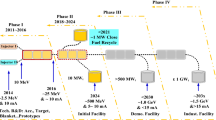Abstract
Purpose
As the world energetic demand is increasing day by day, the development of nuclear energy is of great necessity. However, the development is followed by a lot of tough questions like the management and storage of the nuclear waste. ADS, which is short for the accelerator-driven sub-critical system, may be a good choice because it can provide an efficient transmutations of nuclear waste. Many countries have carried out some research in related areas like the USA, Japan and China.
The superconducting magnet system
The cryomodule I (CM1) for China’s ADS Injection-I had been designed, fabricated and online tested. The CM1 is mainly composed of superconducting spoke cavities, beam position monitors, cryogenic system and superconducting magnets. The superconducting magnet system, which includes the magnet and current leads, is aimed at focusing and correcting the proton beams.
Conclusion
Seven superconducting magnets and current leads for CM1 are successfully designed and manufactured. Structural strength meets design specifications, the field meets the design demands, and the online test shows that the magnets can work in a rather stable state.
In this paper, the detailed design and installation of the superconducting magnets are presented.









Similar content being viewed by others
References
A.F. Zeller, J.C. Dekamp, A. Facco et al., IEEE Trans. Appl. Supercond. 12(1), 329–331 (2002)
F. Yan, Z. Li, C. Meng, Chin. Phys. C 38(2), 82–90 (2013)
W.L. Zhan, Bull. Chin. Acad. Sci 27(3), 375–381 (2012)
L. Han, S. Peng, J. Dai, Chin. Phys. C 36(8), 761–764 (2013)
Q.L. Peng, B. Wang, Y. Chen et al., Chin. Phys. C 38(3), 61–65 (2013)
A. Kalimov, G. Moritz, A.F. Zeller, IEEE Trans. Appl. Supercond. 14(2), 271–274 (2004)
S. Kurz, S. Russenschuck, Electr. Eng. 82(1), 1–10 (1999)
Q.L. Peng, F.Y. Xu, T. Wang, Nucl. Instrum. Methods Phys. Res. 764(1), 220–226 (2014)
M. Leghissa, N. Prölss. US, US 7741944 B2 [P] (20-10)
C. Meuris, Cryogenics 53(53), 17–24 (2013)
S. Ito, T. Miki, M. Hamada et al., IEEE Trans. Appl. Supercond. 14(2), 1715–1718 (2004)
A. Barrarino, IEEE Trans. Appl. Supercond. 12(1), 1275–1280 (2002)
W.M. Joseph, H. Brueck et al., in AIP Conference Proceedings, 2012, pp. 565–572
B. Wang, Q.L. Peng, X.C. Yang et al., Chin. Phys. C 38(6), 93–96 (2013)
W.N. Martin, Science 93(211), 119–121 (1967)
K. Chang, B. Zhao, Y. Lei et al., Cryogenics 25(78), 45–62 (2012)
V.R. Romanovskii, IEEE Trans. Appl. Supercond. 4(2), 1302–1305 (2004)
X.C. Yang, Q.L. Peng, F.Y. Xu, Chin. Phys. C 38(6), 93–96 (2013)
L.D. Innocenti, Sol. Obs. Tech. Interpret. 67(9), 71 (1992)
K. Kawano, K. Hamada, K. Okuno et al., Teion Kogaku 41(3), 105–112 (2006)
Author information
Authors and Affiliations
Corresponding author
Rights and permissions
About this article
Cite this article
Yang, Xc., Peng, Ql., Cheng, D. et al. The superconducting magnet for ADS injection-I. Radiat Detect Technol Methods 3, 2 (2019). https://doi.org/10.1007/s41605-018-0081-z
Received:
Revised:
Accepted:
Published:
DOI: https://doi.org/10.1007/s41605-018-0081-z




